|
|
|
Sort Order |
|
|
|
Items / Page
|
|
|
|
|
|
|
| Srl | Item |
| 1 |
ID:
171549
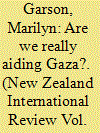

|
|
|
|
|
| Summary/Abstract |
Marilyn Garson discusses the effect of donor states’ actions upon Palestinian lives in the blockaded strip.
|
|
|
|
|
|
|
|
|
|
|
|
|
|
|
|
| 2 |
ID:
182833
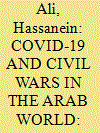

|
|
|
|
|
| Summary/Abstract |
The post-Arab Spring period witnessed the outbreak of devastating civil wars in Syria, Libya and Yemen. These wars had many disastrous impacts on these countries, which threatened their existence as political entities. The Covid-19 pandemic exacerbated the problems facing these countries, especially in light of the collapse of their infrastructure and health care systems. In spite of this, the pandemic and its consequences did not mitigate these civil wars. In this context, this article aims to answer the following question: Why do civil wars continue in the Arab world, despite the Covid-19 pandemic and its disastrous consequences? In other words, why didn't the pandemic create a new dynamic that pushes for the settlement of the civil wars in Syria, Libya and Yemen?
The article provides five reasons to explain this phenomenon. First, the worsening situation in Syria, Libya, and Yemen before the emergence of the Covid-19 pandemic, due to civil wars in these countries turning into protracted conflicts. Second, the nature of the civil wars as proxy wars, due to the large number of regional and international actors that have been involved in each of them. Third, the expansion of war economies in these countries; this phenomenon feeds civil conflict and sustains it. Fourth, the disintegration of the nation state in Syria, Libya, and Yemen, due to the absence of a strong central government, and the multiplicity of actors that control the state's territory. Fifth, the inefficiency of the means to peacefully settle Arab civil wars, mainly through the political efforts of the United Nations.
|
|
|
|
|
|
|
|
|
|
|
|
|
|
|
|
| 3 |
ID:
144337
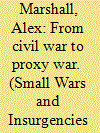

|
|
|
|
|
| Summary/Abstract |
The use of surrogate or ‘proxy’ actors within the context of ‘irregular’ or guerrilla conflict within or between states constitutes a phenomenon spanning nearly the whole of recorded human military history. Yet it is a phenomenon that has also acquired urgent contemporary relevance in the light of the general evolution of conflict in Ukraine and the current Middle East. This introduction to a special issue on the theme investigates some potentially important new avenues to studying the phenomenon in the light of these trends.
|
|
|
|
|
|
|
|
|
|
|
|
|
|
|
|
| 4 |
ID:
125164
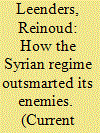

|
|
|
|
|
| Publication |
2013.
|
| Summary/Abstract |
The Assad government watched how uprisings unfolded in Tunisia, Egypt, and Libya, took stock of international reactions to these events, and, in response, developed strategies to maximize its probabilities of survival.
|
|
|
|
|
|
|
|
|
|
|
|
|
|
|
|
| 5 |
ID:
145017
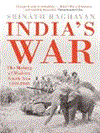

|
|
|
|
|
| Publication |
Gurgaon, Penguin Books India Pvt. Ltd., 2016.
|
| Description |
xvii, 553p.: ill., figures, maps, tableshbk
|
| Standard Number |
9780670086115
|
|
|
|
|
|
|
|
|
|
|
|
Copies: C:1/I:0,R:0,Q:0
Circulation
| Accession# | Call# | Current Location | Status | Policy | Location |
| 058657 | 954.03/RAG 058657 | Main | On Shelf | General | |
|
|
|
|
| 6 |
ID:
124106
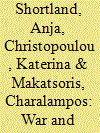

|
|
|
|
|
| Publication |
2013.
|
| Summary/Abstract |
The literature on war economies argues that prolonged civil wars have an economic logic: certain groups may obtain material gains from committing acts of violence and hence resist peacebuilding efforts. Objective tests of these predictions have so far been limited, as corruption and conflict prevent the collection of reliable economic data on the ground. Remote sensing and Geographic Information Science techniques enable us to overcome these problems of terrestrial data collection. Electricity consumption manifested as night-time light emissions recorded in satellite images is proposed as a proxy for changes in disposable income in Somalia's cities. The nightlight images provide striking illustrations of economic decline and recovery and clearly show the contrast between the stable regions of Northern Somalia and the chaos and anarchy of Southern Somalia. Based on geospatial analyses of settlement patterns in Somali cities, we argue that specific metrics of light output can be used to proxy for the incomes of different social groups. We use geo-coded conflict event data to analyze the economic impact of conflict on local light output and therefore incomes. We find a significant peace dividend for poorer households located at the margins of cities, which benefit both from local stability and more peaceful conditions in the country as a whole. By contrast, the central business districts are relatively well insulated from the effects of local conflict, and violence in Mogadishu has positive effects on light output from cities where humanitarian aid agencies are located. Future peace initiatives need to confront these economic incentives for continued conflict and state failure in Somalia.
|
|
|
|
|
|
|
|
|
|
|
|
|
|
|
|
| 7 |
ID:
077181
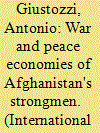

|
|
|
|
|
| Publication |
2007.
|
| Summary/Abstract |
Afghanistan's war economy started taking its current shape after 1992, when the main politico-military actors had to find alternative sources of revenue, having been dropped by their international sponsors. The same actors integrated into the 'peace economy' following the official end to the war in 2001, in a process which resembles the formation of 'mafia' networks, in which the narcotics trade appears to play an important role. If the central government turns out to be too corrupt and uncommitted to address the issue, the international community might one day have to directly engage these actors in order to facilitate their evolution from 'robber barons' to legitimate magnates
|
|
|
|
|
|
|
|
|
|
|
|
|
|
|
|
|
|
|
|
|